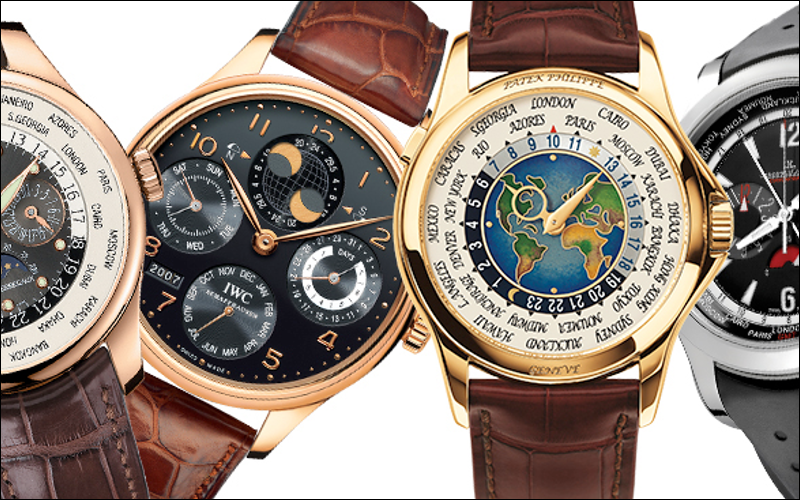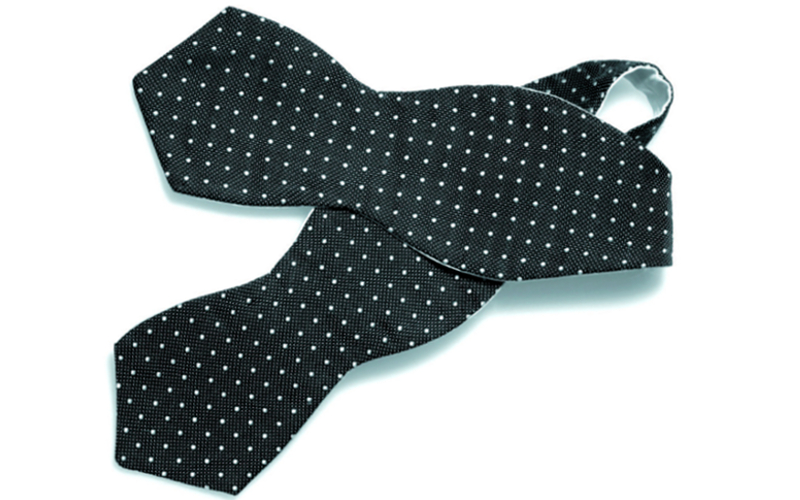
In the Zone
Watches for the Word Traveler
Complex scheduling, multiple time zones and international destinations are par for the course as more and more people are traveling the globe for both business and pleasure. It seems imperative to have a timepiece that keeps pace with a jet set lifestyle. But don’t lose a minute of sleep-the latest generation of world class watches are definitely up to the challenge. Highlighted by a dazzling array of sophisticated functions the following selection is guaranteed to get you to the 1st tee in Dubai or the 19th hole in Singapore on time-and in style. Watches from left to right: Girard-Perregaux WW.TC, IWC Portuguese Perpetual Calendar, Patek Philippe World Time, Jaeger-Le Coultre Master Compressor Extreme World.
Patek Philippe World Time
Highlighted by a handmade cloisonne enamel center dial, the World Time has a host of useful complications that make it coveted by both travelers and collectors. Local time is display by the hour and minute hand, while the crown features a city disk and ring that indicates the day/night time in 24 times zones. The case is crafted of 18k yellow gold and comes with an alligator band; $53,700. patek.com
Girard-Perregaux WW.TC
Crafted in variety of models, the WW.TC combines classic form and high tech function. The automatic chronograph movement is complemented by a perpetual calendar and an inner dial to track time in major cities worldwide; $28,700. girard-perregaux.com
IWC Portuguese Perpetual Calendar
Displaying the phases of the moon as mirror reflections for both the northern and southern hemisphere, the Portuguese Perpetual Calendar keeps accurate track of the lunar cycles It features a mechanical movement, automatic Pellaton winding system, Bruguet spring and perpetual calendar with displays for the day, date, month and year; $29,800. iwc.com
Jaeger-Le Coultre Master Compressor Extreme World
Equipped with a unique shock absorbing system to protect the automatic chronograph movement, the Master Compressor Extreme World boasts an instant display of time in 24 zones, as well as a special changing mechanism that allows a split second switch between leather and rubber wristbands; $10,650. jaeger-lecoultre.com

Black Tie
The Tale of the Tuxedo
Black Tie. Or Cravat Noire, if your host has a playfully cosmopolitan flair. The invitation sparks an intoxicating sense of excitement and anticipation. At the same time, it stirs an uneasy dread and a tinge of fearful apprehension.
And rightly so. Black Tie is, after all, far more than a social invitation. It communicates a sartorial eloquence mastered by few. It is the unspoken but universally understood mandate to arrive properly and appropriately attired—a daunting challenge for both neophytes and those who only occasionally tinker in the ilk of uber-festivities requiring the social gravity and protocol of “Evening Dress.”
Black Tie heralds uniquely special affairs, those reserved exclusively for occasions of Old World grandeur, opulent celebration and festive revelry. Little wonder, then, that satisfying the fashion demands of Black Tie should cause an intimidating and dispiriting sense of fashion insecurity even among the most self-confident. It is serious and deliberate dress fashioned by monarchs, governed by royal protocol and dictated by decades of social custom and ceremony. It is pomp and circumstance—and never to be taken lightly.
For most, Black Tie and tuxedo are synonymous. In England, it is called a dinner jacket. In France, where it is worn in private men’s clubs, it is called le smoking. In Scotland, it is paired with a kilt. And in Bermuda, it is worn with knee-length shorts. Like the chic “little black dress,” the tuxedo is itself the ultimate expression of sophisticated elegance. And like all icons, its timeless design and refined styling is almost always corrupted and spoiled—and seldom improved—by trendy tinkering. That explains the small tolerance given by purists to fad-of-the-moment interpretations.
After dark, or 6:00 p.m.—whichever arrives first—is the traditional bewitching hour when Black Tie is deemed appropriate fashion. White Tie, or Cravat Blanche, on the other hand, does not mean a white dinner jacket, or even a white bow tie with a black tuxedo jacket, as many fashionistas mistakenly think. Instead, White Tie means “full evening dress.” Tailcoat, in other words. Or “tails,” as it is known by its most widely recognized moniker. The type of formal attire an affair requires is clearly stated via the color of bow tie—just remember that White Tie means tailcoat and Black Tie means a tuxedo.
Translating appropriate Black Tie fashion is equally simple. Despite the imposing look of its pomp and circumstance, overcoming that initial, intimidating rush of fashion insecurity that accompanies a formal invitation is accomplished via a simple list of easy-to-remember guidelines that are more social custom than hard-and-fast rules. But once learned, they are the framework for creatively cobbling together your own personal style.
For starters, anyone who wears a suit should not fear a tuxedo. A tuxedo, after all, is little more than a business suit, albeit a more elegant version reserved for evening and adorned with regal detailings. To offset a crowded ballroom’s often stifling heat and offer an added measure of comfort while dancing, tuxedos are typically a lighter weight fabric than business suits. And while “tuxedo” refers to the jacket, it also includes pants and furnishings, along with accessories and footwear.
